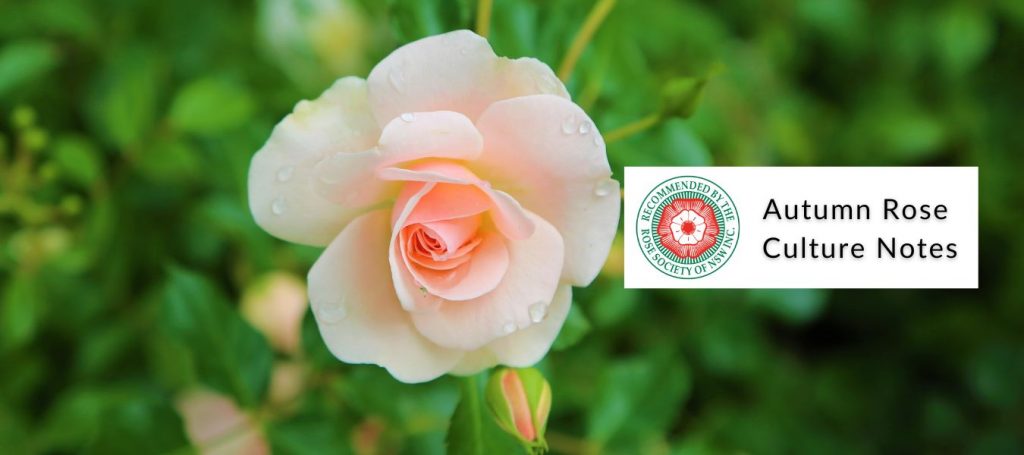
AUTUMN ROSE GROWING CULTURE NOTES FOR NSW
Well Sydney and most of the east coast of NSW has copped a one in one-thousand-year rain event, with some areas receiving over a months’ worth of rain in just a few hours. I hope that wherever you are, that you and your family are safe.
The roses have taken a bit of a beating with all this rain, I know most in my garden are looking a little worse for wear and in need of a dead head. I promise I will get onto it when the sun’s out. Autumn is my favourite time of the year with roses as the weather slowly cools down and some of those bi colour roses really show off with deep blends.
It is also the time to keep watch for pests and diseases. Over the next few months for the NSW cultural notes, I will focus on one Insect pest and its control and one Disease and its control.
- Diseases
Black spot: The menace and the top question by most people who are new to growing roses “how do I get rid of black spot”. Left untreated it can strip your roses of foliage, a rather unpleasant site. In small infestations pick off diseased leaves and remove any that’s fallen on the ground, place in rubbish bin. In bigger situations “eco rose” or “eco fungicide” spray on top and under leaves and around the ground level. Apply every 7-14 days at the rate supplied on the bottle. Make sure you also don’t spray when it’s raining or due to rain or when temperatures are at or above 27 degrees. Both are organic and readily available from independent garden centres.
- Inspect Pests
Aphids: These little creatures are one of the most common pests in roses, and they can breed by the thousands. They not only can suck the sap from the roses, but they can also transfer diseases, they can cause seedlings to wilt and fail and can stunt growth.
Various methods of control are to blast them off with your hose, run your fingers up the stem killing them, encouraging predators such as ladybirds, lacewings and so on which will eat the aphid. Eco oil or Eco neem or a mix of both will help control these pests, a 2nd application will be needed as the eggs that the aphid lays will need to be controlled when hatched. Regular spraying and careful observation will help control aphids. There’s nothing worse then walking out in late winter/early spring and seeing your new shoots covered in aphids.
- Mulch
Whoflungdung: This power pack bale of goodness is like black gold for your garden, it has been composted, inoculated with Neutrog’s eNcase, filled with nutrients and beneficial bacteria. Like most mulches it holds in nutrients, absorbs water, and is packed full of everything and more your garden wants. It is well worth it. Apply to a thickness of around 25mm-100mm. Leave a gap around the stem of your plants to allow further water to penetrate. One bale does 3-6m2, I water Whoflungdung in with Neutrog’s liquid probiotic “GOGO Juice”. It also helps the slight smell go away. I am looking forward to GOGO Juices new sister product “Popul8”, which is a liquid product that has even more goodies in it. It will be a hit with home gardeners and commercial growers, I’m sure. GOGO Juice and Whoflungdung are available at most garden centres and hardware stores.
- Routine Care
Keep up your dead heading. I prune down with the hope of showing my roses, so therefore I want strong new growth on a thick stem that will help add to the quality of the bloom/s I want. Down to a 5-leaf node is sufficient. I look at the show date and work back approximately 50 days and that is when I prune. You could try this for a show or an event you want roses for. I give my roses their 2nd feed (1st being in spring) of Sudden impact for Roses. Apply at 100g per bush or a handful per bush. It has the essential nutrients plus trace elements for roses and I water in with Seamungus, Neutrog’s seaweed tonic. I apply Seamungus every 4 weeks to help aid the growth and development of the new shoots.
Some of you may notice orange hips on your roses. Inside they contain seeds, which more than likely the bees have pollinated it, or the rose has pollinated itself. Cut the hip in half, extract the seeds, place on a paper towel, and wrap and lightly spray with a fungicide. Place in a Chinese takeaway container and put in the crisper of your fridge for 4-6 weeks. Sow out into seedling trays in seed raising mix and keep moist and after 2weeks to 6plus months your seeds should germinate, a flower should appear sometime after, remember like children rose seedlings are never the same. It is a fun and interesting part of rose growing, give it a go.
Enjoy your roses!
Written by Braidan Swan, Rose Society of NSW

